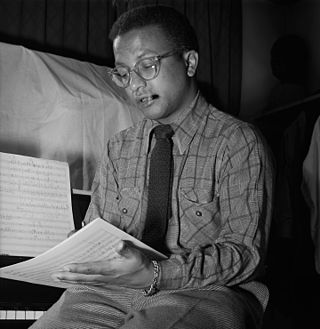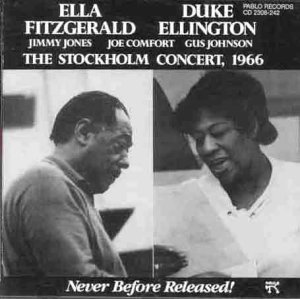Related Research Articles

William Thomas Strayhorn was an American jazz composer, pianist, lyricist, and arranger, who collaborated with bandleader and composer Duke Ellington for nearly three decades. His compositions include "Take the 'A' Train", "Chelsea Bridge", "A Flower Is a Lovesome Thing", and "Lush Life".
"Take the 'A' Train" is a jazz standard by Billy Strayhorn that was the signature tune of the Duke Ellington orchestra.
Quentin "Butter" Jackson was an American jazz trombonist.

Ella at Duke's Place is a 1965 studio album by Ella Fitzgerald, accompanied by the Duke Ellington Orchestra. While it was the second studio album made by Fitzgerald and Ellington, following the 1957 Song book recording, a live double album Ella and Duke at the Cote D'Azur was recorded in 1966. Ella at Duke’s Place was nominated for Best Female Pop Vocal Performance at the 1967 Grammy Awards.

Ella and Duke at the Cote D'Azur is a 1967 live album by Ella Fitzgerald, accompanied by the big band of Duke Ellington.

Take Love Easy is an album by the jazz singer Ella Fitzgerald with guitarist Joe Pass, released in 1974.

The Complete Ella Fitzgerald Song Books were a series of eight studio albums released in irregular intervals between 1956 and 1964, recorded by the American jazz singer Ella Fitzgerald, supported by a variety of orchestras, big bands, and small jazz combos.

The Stockholm Concert, 1966 is a 1966 live album by the American jazz singer Ella Fitzgerald, accompanied in part by the Duke Ellington Orchestra. The recording remained unreleased until 1984.

Ella Fitzgerald Sings the Duke Ellington Song Book is a 1957 studio album by the American jazz singer Ella Fitzgerald, accompanied by Duke Ellington and his orchestra, focusing on Ellington's songs.

The Duke Ellington Songbook, Vol. 1 is an album of Duke Ellington standards performed by Sarah Vaughan. It was recorded in 1979 and released on the Pablo label.
"I Let a Song Go Out of My Heart" is a 1938 composition by Duke Ellington, with lyrics added by Irving Mills, Henry Nemo and John Redmond. The song became a number one hit for Ellington in 1938. Other hit versions the same year were by Benny Goodman, Connee Boswell, Hot Lips Page, and Mildred Bailey. It was performed as part of The Cotton Club Parade of 1938.
"Just Squeeze Me " is a 1941 popular song composed by Duke Ellington, with lyrics by Lee Gaines. The song has been recorded numerous times by a number of artists in the years since, having become a jazz standard. Hit recordings have been by Paul Weston & His Orchestra and by The Four Aces.
"I'm Just a Lucky So-and-So" is a 1945 song composed by Duke Ellington, with lyrics written by Mack David.
"All Too Soon" is a 1940 song composed by Duke Ellington with lyrics written by Carl Sigman. It is recorded in the key of C major. It was subsequently recorded by several contemporary and modern artists.
"Just A-Sittin' and A-Rockin'" is a 1941 song written by Billy Strayhorn and Lee Gaines.
"Day Dream" is a jazz standard composed by Billy Strayhorn with lyrics by John Latouche and written in 1939. It was first recorded by saxophonist Johnny Hodges and his ensemble on November 2, 1940. Duke Ellington was credited as co-composer on the label of the original 78 RPM release, though he is not generally considered to be one of the song's creators.

The Duke Ellington Songbook, Vol. 2 is a 1979 album by Sarah Vaughan, focusing on the works of Duke Ellington.
"I Ain't Got Nothin' but the Blues" is a 1937 song composed by Duke Ellington, with lyrics written by Don George.

"Chelsea Bridge" (1941) is an impressionistic jazz standard composed by Billy Strayhorn.

"Something to Live For" is a 1939 jazz composition by Billy Strayhorn. It was the first collaboration between Strayhorn and Duke Ellington and became the first of many Strayhorn compositions to be recorded by Ellington's orchestra. The song was based on a poem Strayhorn had written as a teenager. According to an all-day tribute to Strayhorn on KCSM radio on 29 November 2008—Strayhorn's birthday—Strayhorn began working on this tune in 1933 when he was 18.
References
- ↑ Cohen 2010, p. 180.
- ↑ Cohen 2010, p. 309.
- ↑ Walter van de Leur (31 January 2002). Something to Live For: The Music of Billy Strayhorn. Oxford University Press. p. 290. ISBN 978-0-19-802885-7.
- ↑ Michael Denning (1998). The Cultural Front: The Laboring of American Culture in the Twentieth Century. Verso. p. 316. ISBN 978-1-85984-170-9.
- ↑ Franceschina 2017, p. 32.
- ↑ Franceschina 2017, p. 36.
- ↑ Franceschina 2017, p. 200.
- ↑ "Vital Reissues". Billboard. Nielsen Business Media, Inc. 7 February 1998. p. 75.
- ↑ The Crisis Publishing Company, Inc. (June–July 1990). The Crisis. The Crisis Publishing Company, Inc. p. 12.
- Cohen, Harvey G. (15 May 2010). Duke Ellington's America . University of Chicago Press. ISBN 978-0-226-11264-0.
- Franceschina, John (6 July 2017). Duke Ellington's Music for the Theatre. McFarland. ISBN 978-0-7864-5026-8.